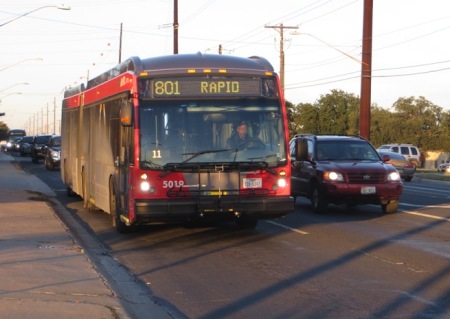
Roger Baker speaks to CAMPO committee, 14 Nov, 2011. Screengrab from YouTube video by Winter Patriot.
♦
Under the leadership of Kyle Keahey, designated in early 2013 as Urban Rail Lead, Project Connect’s former “urban rail” planning has morphed into “high-capacity-transit” planning — apparently moving away from urban rail and toward embracing so-called “bus rapid transit” (“BRT”) as its new mode du jour. Represented by Capital Metro’s new MetroRapid bus operation, the newly favored “BRT” is in reality merely a version of ordinary limited-stop bus service modestly upgraded with extra features like traffic signal prioritization, nicer stops, nicer and larger buses with amenities like Wi-Fi … but it’s not rapid transit. (And may even represent an overall degradation of service in the corridor.) See: Why MetroRapid bus service is NOT “bus rapid transit”.
In this commentary, Roger Baker provides a perspective of background and analysis helping explain why Project Connect, the City of Austin, and Capital Metro seem to be now leading Austin’s rail planning way off the rails and not merely into a ditch, but over a cliff.
By Roger Baker
Austin has persistently lacked a strong progressive populist voice, like a crusading newspaper, willing to dig in and take sides against the prevailing business interests. Even though Austin is liberal compared to Texas, we have an unprincipled Democratic mayor willing to make Toronto’s discredited right-wing mayor Rob Ford an honorary citizen, and equally willing to cut sleazy deals with local business interests tied to certain favorite rail alignments and other official projects.
At the top of state politics, we have Gov. Rick Perry’s climate change deniers and transportation cronies running TxDOT, trying to attract cheap-labor jobs, and to maintain profitable suburban sprawl development, which is creating huge budget shortfalls at TxDOT.
The proceeds from land development as usual are disappearing into the Hip Pocket National Bank.
If we had adult supervision and rational enforcement of sound transit planning on the federal level, coming from the Federal Highway Administration (FHWA) and Federal Transit Administration (FTA), we might be in good shape. But what mid-level federal officials are willing to lose their jobs by crossing the Republicans who run our state for the benefit of the landed gentry?
Austin is also facing a water crisis, likely even more serious than California’s, since Austin’s water comes from now bone dry West Texas. Our daily paper has admitted that we face a water crisis, but without ever mentioning global warming or climate change.
Given all this, special-interest-oriented light rail planning tends to prevail, and the public doesn’t have easy media access to good analysis of rail corridor alternatives.
A likely reason that Austin transportation planners are now redirecting their focus toward BRT instead of rail, is that the special interests involved have run voter polls and see that an urban rail election (required to approve local bond funding) is likely to fail, and they are hedging their bets. Five years from now maybe average folks will get frustrated enough with Austin’s already severe congestion to be broadly supportive of rail, but for now an election might not succeed. Also, our rail-hating opponents are aligned with the Texas road lobby who want roads to complement the current Austin growth boom.
Our six-county MPO, CAMPO, is doing a $32 billion transportation plan that would put 70% of our year 2040 population growth (supposedly doubled by then) in the five counties ringing Travis County, the county which includes Austin. This is like a prescription for an extreme suburban sprawl land use future, which by its nature is road-dependent low-density development that can’t be served efficiently by transit.
This plan can’t work, but the idea is to get federal approval to channel our shrinking fuel tax revenues toward roads to serve sprawl development, before the shortcomings become apparent.











